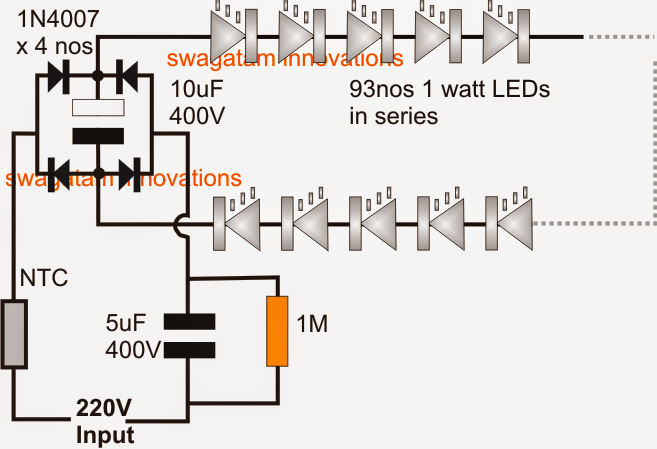The post talks about a relatively easy 100 watt LED bulb circuit utilizing a few high voltage capacitors. The whole circuit might be developed at a cost much less than $25.
We have by now mentioned a lot of capacitive type of transformerless power supply circuits within this website, in spite of this each one of these is affected with a number of problems, specifically insufficient optimal current output, and surge inrush weakness.
Upon researching capacitive power provides deeply I possibly could summarize a couple of essential issues relating to these choices:
Capacitive power supplies are usually such as solar panels which work effectively, at their highest power point specifications while they are controlled with their open circuit voltages, elsewhere the current features from these types of units undergo serious losses and generate extremely ineffective outcomes.
In basic terms if we one wishes to obtain high current outputs from a capacitive power supplies at will, the circuit will have to be managed with a load owning a voltage necessity equivalent to the optimum output of the system.
For instance with a 220V input, a capacitive power supply after rectification would certainly deliver an output of around 310V DC, so any load designated with a 310V rating could possibly be controlled with complete effectiveness and at any needed current level based upon the requirement of the load.
If the above problem is pleased, it also tackles the current inrush situation, considering that the load is selected at 310V, an inrush of full input voltage now has no impact on the load and the load stays safe even throughout immediate turn on of the circuit.
In the suggested 100 watt LED bulb circuit we utilize the similar method as talked about in the above segments.
As talked about, if the input is 220V the load might need to be rated at 310V.
With 1 watt 350mA standard LEDs this may imply adding 310/3.3 = 93 LEDs in series, that's near to 100nos.
A single 1uF/400V capacitor generates around 60mA current at the above specific 310V DC, consequently for attaining the needed 350mA more such capacitors will have to be inserted identical, to be accurate a total of 350/60 = 5 capacitors, that might also be a single 5uF/400V but ought to be a nonpolar type.
An NTC thermistor might be included for additional safety, even though it most likely are not absolutely essential.
In the same way a resistor may very well be also incorporated to offer extra bit of safety from unsteady voltage problems.
The resistance value might be around determined as R = Us - VFd/I = 310-306/.35 = 10 ohm, 1 watt
For a 120V input, the above specifications would basically have to be halved, that is use 47nos of LEDs rather than 93, and for the capacitor a 5uF/200V might be sufficient.

Leave a Reply